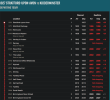RobertsN
Member
I'm just curious on this one and I'd appreciate any (polite) input on the issue.
I just noticed a train leaving Stratford-upon-Avon (SAV) 25 and 1/4 minutes late. I know there are 4 request stops along the way, however, most of them don't have a clear line of sight to approach at line speed.
However, by Tyseley, the delay was down to 8 minutes (admittedly with 2 minutes engineering allowance). If a train can do the trip in around 15 minutes - subtracting the engineering allowance, does this mean timetables are padded out to reduce the chance of delay repayment or what else does it actually mean? There are no complicated junctions before hitting Tyseley, so if that much can be knocked off that easily, there may be something not quite right?
BTW, the train was down to +1 by Birmingham Moor Street (with an additional engineering minute). For reference, 2K73 today from SAV.

I have also noticed that the timings into Marylebone from Neasden stand at up to 11 minutes for 5 miles of track (and I don't believe most of it is done at around 30 mph). The reason I mention this is that quite often when travelling into London with a significant delay we suddenly pick up quite a few minutes in the last bit to avoid hitting the 15-minute mark of lateness. I can understand an additional minute or 2 due to station throat congestion, but it does seem a bit too much.
I just noticed a train leaving Stratford-upon-Avon (SAV) 25 and 1/4 minutes late. I know there are 4 request stops along the way, however, most of them don't have a clear line of sight to approach at line speed.
However, by Tyseley, the delay was down to 8 minutes (admittedly with 2 minutes engineering allowance). If a train can do the trip in around 15 minutes - subtracting the engineering allowance, does this mean timetables are padded out to reduce the chance of delay repayment or what else does it actually mean? There are no complicated junctions before hitting Tyseley, so if that much can be knocked off that easily, there may be something not quite right?
BTW, the train was down to +1 by Birmingham Moor Street (with an additional engineering minute). For reference, 2K73 today from SAV.

I have also noticed that the timings into Marylebone from Neasden stand at up to 11 minutes for 5 miles of track (and I don't believe most of it is done at around 30 mph). The reason I mention this is that quite often when travelling into London with a significant delay we suddenly pick up quite a few minutes in the last bit to avoid hitting the 15-minute mark of lateness. I can understand an additional minute or 2 due to station throat congestion, but it does seem a bit too much.


